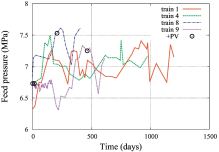Últimas investigaciones:
Proyecto de investigación co-edu: Competencias transversales desde la EIIC para su ecosistema social11 Dic 2022
Carreteras sostenibles con geomateriales volcánicos
28 Jul 2022
Competencias transversales desde la EIIC para su ecosistema social
1 Jun 2022
Benefits of inclined pile foundations in earthquake resistant design of bridges
30 Dic 2019
Groundwater Quality Assessment in a Volcanic Mountain Range (South of Gran Canaria Island, Spain)
11 Abr 2019
Ir a investigación

1 Ene 2019
Different boron rejection behavior in two RO membranes installed in the same full-scale SWRO desalination plant
Abstract
Today, one of the main targets of seawater reverse osmosis (SWRO) membrane manufacturers is to increase boron rejection. For drinking water, the regulations in Spain are quite strict in terms of maximum boron content. The aim of this work is to propose a prediction model for average boron permeability coefficient as boric acid by evaluating the fluctuations of boron permeate concentration due to the different operating conditions of the plant under study. The SWRO desalination plant used for this study is located in Spain and has 9 trains with a production capacity of around 7200 m3 d−1 per train. Data from about 1500 operating days were considered. Operating data including pressure, conductivity, flow, temperature, pH and boron permeate concentration were collected during the study period. All racks did not have the same number of pressure vessels or operating conditions. Boron permeate concentration was between 0.5 and 2 mg L−1 for the membrane element TM820S-400 and between 0.25 and 0.75 mg L−1 for the membrane element TM820L-440. The model is based on the superposition of three exponential functions considering the influence of feed pressure, feed-brine temperature and operating time. The obtained results with the proposed model showed more adaptable to the experimental data than previous model.